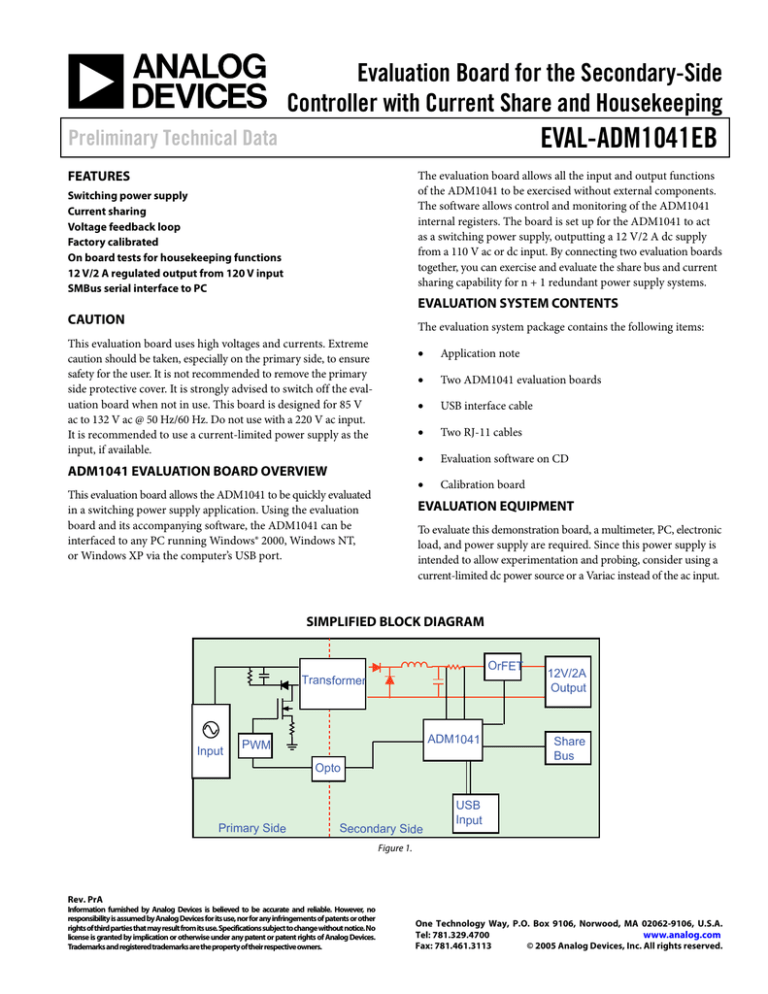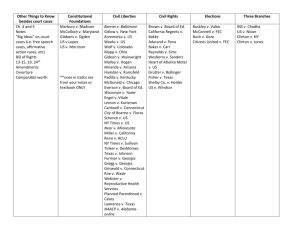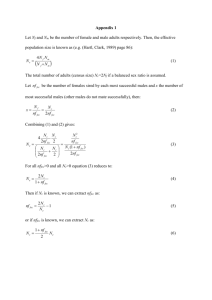
Evaluation Board for the Secondary-Side
Controller with Current Share and Housekeeping
EVAL-ADM1041EB
Preliminary Technical Data
The evaluation board allows all the input and output functions
of the ADM1041 to be exercised without external components.
The software allows control and monitoring of the ADM1041
internal registers. The board is set up for the ADM1041 to act
as a switching power supply, outputting a 12 V/2 A dc supply
from a 110 V ac or dc input. By connecting two evaluation boards
together, you can exercise and evaluate the share bus and current
sharing capability for n + 1 redundant power supply systems.
FEATURES
Switching power supply
Current sharing
Voltage feedback loop
Factory calibrated
On board tests for housekeeping functions
12 V/2 A regulated output from 120 V input
SMBus serial interface to PC
EVALUATION SYSTEM CONTENTS
CAUTION
The evaluation system package contains the following items:
This evaluation board uses high voltages and currents. Extreme
caution should be taken, especially on the primary side, to ensure
safety for the user. It is not recommended to remove the primary
side protective cover. It is strongly advised to switch off the evaluation board when not in use. This board is designed for 85 V
ac to 132 V ac @ 50 Hz/60 Hz. Do not use with a 220 V ac input.
It is recommended to use a current-limited power supply as the
input, if available.
ADM1041 EVALUATION BOARD OVERVIEW
This evaluation board allows the ADM1041 to be quickly evaluated
in a switching power supply application. Using the evaluation
board and its accompanying software, the ADM1041 can be
interfaced to any PC running Windows® 2000, Windows NT,
or Windows XP via the computer’s USB port.
•
Application note
•
Two ADM1041 evaluation boards
•
USB interface cable
•
Two RJ-11 cables
•
Evaluation software on CD
•
Calibration board
EVALUATION EQUIPMENT
To evaluate this demonstration board, a multimeter, PC, electronic
load, and power supply are required. Since this power supply is
intended to allow experimentation and probing, consider using a
current-limited dc power source or a Variac instead of the ac input.
SIMPLIFIED BLOCK DIAGRAM
OrFET
Transformer
Input
ADM1041
PWM
12V/2A
Output
Share
Bus
Opto
Primary Side
Secondary Side
USB
Input
Figure 1.
Rev. PrA
Information furnished by Analog Devices is believed to be accurate and reliable. However, no
responsibility is assumed by Analog Devices for its use, nor for any infringements of patents or other
rights of third parties that may result from its use. Specifications subject to change without notice. No
license is granted by implication or otherwise under any patent or patent rights of Analog Devices.
Trademarks and registered trademarks are the property of their respective owners.
One Technology Way, P.O. Box 9106, Norwood, MA 02062-9106, U.S.A.
Tel: 781.329.4700
www.analog.com
Fax: 781.461.3113
© 2005 Analog Devices, Inc. All rights reserved.
EVAL-ADM1041EB
Preliminary Technical Data
TABLE OF CONTENTS
Features .............................................................................................. 1
Overcurrent....................................................................................8
Caution............................................................................................... 1
Local Short/Undervoltage ............................................................8
ADM1041 Evaluation Board Overview......................................... 1
Evaluation Board Software...............................................................9
Evaluation System Contents............................................................ 1
Installing the Software ..................................................................9
Evaluation Equipment...................................................................... 1
Using the Software ........................................................................9
Simplified Block Diagram ............................................................... 1
Communicating with the ADM1041....................................... 10
Revision History ............................................................................... 2
Reading and Writing to the ADM1041 ................................... 10
Evaluation Board Hardware ............................................................ 3
Data Read/Write......................................................................... 10
Connectors .................................................................................... 3
EEPROM ..................................................................................... 11
USB Interface Connector J7........................................................ 3
Calibration Routine/Board ....................................................... 12
Getting Started .................................................................................. 4
Calibration Routine Procedure ................................................ 12
PS_ON ........................................................................................... 5
Silkscreen......................................................................................... 13
Housekeeping Evaluation............................................................ 5
Schematics ....................................................................................... 14
Overcurrent—Shutdown ............................................................. 5
Parts List .......................................................................................... 16
Overcurrent—Constant Current Operation............................. 5
Ordering Information.................................................................... 18
Load Overvoltage ......................................................................... 5
Ordering Guide .......................................................................... 18
Current Sharing ............................................................................ 6
ESD Caution................................................................................ 18
Hot Swap........................................................................................ 8
REVISION HISTORY
11/05—Revision PrA: Preliminary Version
Rev. PrA | Page 2 of 20
Preliminary Technical Data
EVAL-ADM1041EB
EVALUATION BOARD HARDWARE
A typical ac/dc switching power supply forward converter
topology is the basis for the evaluation board. Figure 1 shows a
block diagram of the main components on the board. The
primary side consists of the input terminals and transformer.
PWM of the primary side switch is controlled by the UC3844A,
which receives its control signal through the optocoupler. This
controls the switching of the transformer. A maximum duty
cycle of 50% is allowed. The primary control system is powered
by a bleed resistor during startup, and by a tap winding from
the power transformer thereafter.
The secondary side power stage consists of the diode rectifiers,
output filter, sense resistor, and OrFET. This provides 12 V @
2 A at the output. The ADM1041 is also located on the
secondary side. It provides the feedback signal that is used to
regulate the voltage, limit the current, and allow current sharing
and shutdown to be implemented. High-side current sensing is
used. The ADM1041 also controls the share bus, which allows
multiple power supplies to perform load sharing. The
ADM1041 feedback to the primary side, through the
optocoupler, consists of the voltage sense, current sense, and
share bus information.
The USB section is also located on the secondary side. This
allows the PC software to communicate with the evaluation
board (and with other evaluation boards through the RJ-11
connectors) through the USB port of the PC. You can readily
change register settings on the ADM1041 this way and also
monitor the status registers.
Various manual controls and indicators, such as LEDs, switches,
and buttons, allow you to exercise the voltage control loop and
the housekeeping functions. The evaluation board is designed
with a 0.1 Ω RSENSE resistor. The power supply is designed to
support a maximum continuous output of 2 A. The current
sense amplifier is calibrated such that 2 A corresponds to 100%
of output current rating. The current limit threshold cannot be
programmed beyond 130%.
A variable load is required to perform a thorough evaluation.
The output voltage is available between J2 and J3; this is also
where the load should be connected. The power supply is in
continuous conduction mode (CCM) above 0.5 A load. Below
0.5 A load, the power supply is in discontinuous conduction
mode (DCM). A load of greater than 0.2 A is required to ensure
stability. The output voltage ripple is approximately 100 mV p-p.
CONNECTORS
The connections to the evaluation board are shown in Table 1.
Table 1. Evaluation Board Connections
Connector
J1
J2
J3
J4
J5
J6
J7
J8
J9
Evaluation Board Function
110 V ac input
VOUT+/LOAD+
VOUT−/LOAD−
Share bus
RJ-11 connector
RJ-11 connector
USB interface
Primary input voltage ground
Primary input voltage
USB INTERFACE CONNECTOR J7
The connections to J7 are shown in Table 2.
Table 2. J7 Connections
J1 Pin
1
2
3
4
Rev. PrA | Page 3 of 20
ADM1041 Function
5V
SCL
SDA
Ground
EVAL-ADM1041EB
Preliminary Technical Data
GETTING STARTED
Do not connect the USB cable to the evaluation board until the
software is installed.
1.
Install the ADM1041 software. If it is already installed, skip
to the next step.
2.
Connect the evaluation board to the USB port on the
computer, using the USB interface cable provided. See
Figure 2 to see how to set up the board. Run the software.
3.
For the input voltage source, an ac or dc power supply can
be used. For an ac source, apply 85 V ac ~ 132 V ac. For a
dc source, apply 100 < 150 V dc. This input voltage is the
signal that is regulated to provide a 12 V/2 A supply at the
output.
4.
The evaluation board is now ready to evaluate the
ADM1041.
Multimeter
Or
Scope
OrFET
Electronic
Load
0 -> 2A
Transformer
120V
Power
Supply
ADM1041
PWM
Share
Bus
Opto
RJ11
Primary Side
Secondary Side
USB Cable from PC
Figure 2. Getting Started
Rev. PrA | Page 4 of 20
USB
RJ11
Preliminary Technical Data
EVAL-ADM1041EB
PS_ON
There are two ways to turn the power supply on and off with
this control. Use SW2 to toggle the PS_ON pin. Alternatively,
the PS_ON polarity can be toggled using the software. This has
the same effect as toggling the switch connected to PS_ON to
the opposite polarity. In general, it is recommended to use one
method or the other.
HOUSEKEEPING EVALUATION
The ADM1041 performs many housekeeping functions in the
power supply. The evaluation board allows you to simulate
various faults that could affect the ADM1041 in a working
system. You can monitor how the ADM1041 handles this event
in many ways. One way is to use an oscilloscope and/or
multimeter to probe the evaluation board to see various
conditions in the system. Many testpoints are provided for this
function. You can also use the software to read back register
contents, which show the conditions of the ADM1041 and how
it has reacted to the event. The software is described in the
Evaluation Board Software section. A fault LED on the board
can be configured to indicate certain fault conditions. An LED
monitors the status of the OR’ing FET to indicate whether the
power supply is connected to the output terminals. An LED on
the primary side indicates that power is present on the primary
side.
OVERCURRENT—SHUTDOWN
OVERCURRENT—CONSTANT CURRENT
OPERATION
Using the ADM1041, the power supply can be configured to
operate in a constant current mode. The current limit disable
bit of Register 11 needs to be set. An OCP condition can be
simulated by applying an electronic load of greater than 2 A.
Once the load current is greater than the OCP threshold limit
(programmable from 105% to 130%), the OCP flag is set.
Unlike in the preceding Overcurrent—Shutdown section, the
ADM1041 does not turn off the OrFET. Instead, the power
supply operates in constant current mode.
LOAD OVERVOLTAGE
By applying a higher voltage (that is, 13 V) than the load voltage
(12 V) to J2, response to a load overvoltage condition can be
evaluated. The OR’ing FET is quickly turned off. In software,
the Load_OV, Reverse_OK, and OrFET_OK flags are set.
Monitor Testpoint 5 to see the gate voltage of the OrFET
change. The ADM1041 turns off the output until the fault is
removed (when you remove the overvoltage). When the fault is
removed, the ADM1041 clears the flags and returns to normal
operation. The OrFET gate voltage on Testpoint 5 returns to a
low value. In software, go to the ADM1041 Status Registers
dialog and click Begin Polling. Once an overvoltage is present,
the Load_OV, Reverse_OK, and OrFET_OK bits go low. When
the fault is removed, these bits go high again, indicating normal
operation.
The overcurrent protection (OCP) function can be tested by
increasing the output current beyond 2 A. Once the load
current is greater than the OCP threshold limit (programmable
from 105% to 130%), the OCP flag is set. After the OCP
timeout (programmable from 1 to 4 seconds) is reached, the
ADM1041 turns off the OrFET, which shuts down the power
supply. It keeps the power supply in shutdown mode until the
load current is reduced below the OCP threshold and you
perform a hardware or software PS_ON.
Rev. PrA | Page 5 of 20
EVAL-ADM1041EB
Preliminary Technical Data
CURRENT SHARING
By connecting two evaluation boards together, the ADM1041
can be evaluated in a redundant n + 1 power supply
configuration. Figure 3 shows how the two boards should be
connected together. Use the black RJ-11 cable when connecting
the boards together; the white cable is for connecting to the
calibration board.
First, power up each evaluation board. Apply power on the
primary side. There should now be 12 V across J2/J3 of each
board. Apply the electronic load to Board A. The boards
perform current sharing. One way to monitor this is to monitor
the voltage drop across each sense resistor. This should be
approximately 100 mV when current sharing.
BOARD A
OrFET
Electronic
Load
0 -> 2A
Transformer
120V
Power
Supply
Share
Bus
ADM1041
PWM
Opto
RJ11
Primary Side
Secondary Side
RJ11
USB
USB Cable from PC
BOARD B
OrFET
Transformer
120V
Power
Supply
ADM1041
PWM
Share
Bus
Opto
RJ11
Primary Side
Secondary Side
USB
Figure 3. Current Share Configuration
Rev. PrA | Page 6 of 20
RJ11
Preliminary Technical Data
EVAL-ADM1041EB
Now remove the connection between both J2 connectors. This
means that Board A is now providing all of the power for the
load. The voltage drop across the sense resistor on Board A
should be approximately 200 mV, and the voltage drop across
the sense resistor of Board B should be approximately 0 mV. See
Figure 4.
BOARD A
OrFET
Electronic
Load
0 -> 2A
Transformer
120V
Power
Supply
Share
Bus
ADM1041
PWM
Opto
RJ11
Primary Side
Secondary Side
RJ11
USB
USB Cable from PC
BOARD B
OrFET
Transformer
120V
Power
Supply
ADM1041
PWM
Share
Bus
Opto
RJ11
Primary Side
Secondary Side
USB
Figure 4. Current Configuration with No Sharing
Rev. PrA | Page 7 of 20
RJ11
EVAL-ADM1041EB
Preliminary Technical Data
HOT SWAP
LOCAL SHORT/UNDERVOLTAGE
By adding (and removing) the connection between J2 on
Board B to Board A, you can evaluate how each board reacts
when a new power supply is added to (or removed from) the
system.
A short to ground at the negative terminal of RSENSE simulates
a local undervoltage fault. Begin by having both boards sharing
a 2 A load. Apply the short at RS− (Testpoint 2) of Board B.
This causes a Reverse_OK fault on Board B, which turns off its
output and contribution to the load. Now Board A must supply
all of the current to the load. The multimeter monitoring
Board B shows a reduction in voltage drop across its RSENSE to
approximately 0 mV. The multimeter monitoring Board A
shows an increase in voltage drop as it takes over the system
and provides all of the current for the load. The ADM1041 on
Board B keeps its contribution to the power supply system
turned off until a PS_ON is performed. It then contributes
again to the current sharing configuration.
OVERCURRENT
An OCP condition can also be evaluated. Begin with both
boards sharing a 2 A load. Increase the load current to 2.5 A.
Remove the J2 connection from Board B to Board A. This
means that Board A is now providing all of the power—more
power than it is programmed to provide. It goes into OCP
condition and shuts down the power supply.
Rev. PrA | Page 8 of 20
Preliminary Technical Data
EVAL-ADM1041EB
EVALUATION BOARD SOFTWARE
The software allows the ADM1041’s functions to be controlled
from the PC via an easy to use interface operating under the
Windows environment. The contents of the device’s internal
registers can easily be read or altered through a user-friendly
graphical interface.
INSTALLING THE SOFTWARE
To install the software:
1.
Insert the CD-ROM into the CD-ROM drive. Select Start
> Run, and enter X:ADM1041.exe, where X is the letter of
your CD-ROM drive. Click OK.
2.
To use the software immediately, you must restart your
computer so that Windows can update the setup files. To
do this, click Yes. If you do not want to use the software
immediately, click No.
3.
No matter which option you select, click Finish to
complete the installation.
USING THE SOFTWARE
Before using the software, ensure that the evaluation board is
powered up and connected to the PC. To start the software,
select Start > Programs > Analog Devices > ADM1041
Evaluation Software > ADM1041 Evaluation Software. The
main evaluation window appears. The software automatically
looks for an ADM1041 on the SMBus. Once it recognizes an
ADM1041, it communicates to that SMBus address. Therefore,
you should not need to change any settings to begin communication between the software and the evaluation board.
The main window (Figure 5) displays information about the
ADM1041’s internal registers.
Figure 5. ADM1041 Main Window
Rev. PrA | Page 9 of 20
EVAL-ADM1041EB
Preliminary Technical Data
COMMUNICATING WITH THE ADM1041
The software automatically finds all ADM1041s on the SMBus.
When the main window loads, the address of the ADM1041 is
displayed in the SMBus Address of the ADM1041 box. See
Figure 6. If you have more than one board connected together
(through the RJ-11 cable), there is more than one ADM1041 on
the SMBus. In this case, the software shows the ADM1041 with
the highest SMBus address. To communicate with the other
ADM1041, simply choose the other ADM1041 from the dropdown menu, using the correct SMBus address. Alternatively,
you can write to all ADM1041s on the bus at the same time by
choosing Broadcast Address from the drop-down menu.
The SMBus address of the ADM1041 can be changed by
changing the SW3 switch. This should be done before running
the software.
Figure 7. Register Box on Main Window
DATA READ/WRITE
Figure 6. SMBus Address Drop-Down Menu on Main Window
Using the software to read/write data to the ADM1041 can be
done in many ways.
READING AND WRITING TO THE ADM1041
The main ways to communicate with the ADM1041 are all
accessed through the main window. See Figure 7. The quickest
way is to scroll through the register list of the Ram Byte
Read/Write section of the main window. As you scroll, the main
window displays the following for the selected register:
•
Register name
•
Register hexadecimal address
•
Register contents overview
•
Register contents in hexadecimal and binary
Clicking Open Register Details displays a more detailed look at
the register selected. You can also click the list of registers in the
RAM register contents list. This automatically changes content
of the register description, as described previously.
Register Read
On the main window, the contents of the selected register are
displayed at all times.
Register Write—Basic
1.
On the main window, select the register that needs to be
changed, as described previously. The contents of the
selected register are displayed.
2.
Type the new hexadecimal value into the Register
Contents (Hex) box.
3.
Click Write to Register. The new value is written to the
ADM1041.
Rev. PrA | Page 10 of 20
Preliminary Technical Data
EVAL-ADM1041EB
Register Write—Detailed
EEPROM
1.
The EEPROM is controlled on the main window.
On the main window, click the register that you need to
change. For example, to change the reverse voltage turn-off
threshold, select the Reverse Voltage Threshold register.
2.
Click Open Register Details. This opens the Reverse
Voltage Detector dialog, which displays details
information about the register. See Figure 7.
3.
Click the new value of reverse voltage in the Rev Volt Off
column. The software automatically calculates the hexadecimal and binary values of the new register contents. It
also automatically updates this register in the ADM1041.
4.
To view the contents of each page of the EEPROM, click Read
32 bytes from EEPROM after entering the associated page
number. This displays the entire contents of that page of the
EEPROM.
To view the contents of the entire EEPROM, click View Entire
EEPROM. This opens the ADM1041 EEPROM dialog. Click
Read Entire EEPROM to view the data.
To exit, click Exit.
Saving the Factory EEPROM Values
To return to the main window, click Exit.
The EEPROM contents can be saved to a text file for future use.
It is advised that you perform this function before evaluating
other features of the ADM1041, particularly before writing new
values to the EEPROM. This allows you to reprogram the
ADM1041 to the original factory settings if the EEPROM data
is lost due to incorrect writing to the part. Select File > Save.
Select a folder in which to save the data, enter a new file name
or select an existing file name for the data, and click Save. The
data is stored in a .dat file. To open an existing file, select File >
Load and select the appropriate data file.
Figure 7. Reverse Voltage Detector Dialog
Updating the EEPROM
Continuous Read
Continuous read is for use in exercising fault conditions.
Clicking the Status Regs menu opens the ADM1041 Status
Registers dialog (Figure 8). This is a very useful evaluation tool
because you can see the status register contents in real time.
Opening this dialog automatically starts the continuous reading
of the three status registers. If a fault occurs, the status register
reports this fault in real time. This should be used when
evaluating the ADM1041’s reaction to fault conditions, like
those described in the Housekeeping Evaluation section.
Clicking View Latched Registers opens the Latched Registers
dialog. If a flag is set and then removed, the latched registers
remember the event.
To change any of the EEPROM contents, click Update RAM
Contents to EEPROM on the main window. See Figure 9. You
are then asked to verify this change, because it means that the
previous content of the EEPROM will be lost permanently.
Click Yes to load the new data into the EEPROM. The new
values are now stored in EEPROM.
Since the data is transferred from the EEPROM to the part only
when the part powers up, nothing happens initially. The new
EEPROM data is loaded into the ADM1041 registers only if you
power down the ADM1041 and then power it up again.
Figure 8. ADM1041 Status Registers Dialog
Figure 9. EEPROM Register Contents
Rev. PrA | Page 11 of 20
EVAL-ADM1041EB
Preliminary Technical Data
EEPROM Data Log
A mulitmeter on the load voltage (across J2 and J3) and on the
share voltage (across J4 and J3) can be used to monitor the
calibration. After about 30 seconds, the calibration is complete.
The load voltage and the share bus maximum and minimum
load voltages now match the values that you input before
calibration.
The EEPROM contents can be saved to a text file for future use.
This means that you can load up the ADM1041 in your specific
default state. It also allows register settings to be easily shared
and duplicated between PCs and setups.
Select File > Save. Select a folder in which to save the data,
enter a new file name or select an existing file name for the data,
and click Save. The data is stored in a .dat file. To open an
existing file, select File > Load. Select the appropriate data file.
CALIBRATION ROUTINE PROCEDURE
The calibration routine is as follows:
1.
Remove the OCP and OVP limits.
2.
Calculate the correct current sense gain setting.
3.
Determine the polarity of the common-mode error and
adjust if necessary.
4.
Calculate and program Register 14h to remove the
common-mode error.
To perform a calibration
5.
Program Register 19h to achieve the desired load voltage.
1.
Click CALIBRATION ROUTINE on the main window. A
Calibration dialog appears.
6.
Apply full load and adjust the share bus slope to calibrate
the share bus.
2.
Click Remove Previous Calibration Settings.
7.
Remove load.
3.
Input the required output voltage and the share bus
maximum and minimum load voltages.
8.
Replace the OCP and OVP limits.
4.
Click Calibrate to perform the calibration.
CALIBRATION ROUTINE/BOARD
A calibration routine and board are included to demonstrate the
ability to automate the calibration and trimming process in a
production environment. The calibration board is connected to
the evaluation board as shown in Figure 10. (Use the white
RJ-11 cable provided. The black cable is for connection between
two ADM1041 boards.)
Electronic
Load
0 -> 2A
BOARD A
CAL BOARD
OrFET
Transformer
120V
Power
Supply
ADM1041
PWM
Share
Bus
Opto
RJ11
Primary Side
Secondary Side
USB
USB Cable from PC
Figure 10. Calibration Board Setup
Rev. PrA | Page 12 of 20
RJ11
RJ11
Preliminary Technical Data
EVAL-ADM1041EB
SILKSCREEN
Figure 11. ADM1041 Evaluation Board Silkscreen
Rev. PrA | Page 13 of 20
Figure 12. ADM1041 Evaluation Board Schematic
Rev. PrA | Page 14 of 20
A
B
C
1
1
C26
1uF
5
6
7
8
GND
NR
OUT
OUT
ADP3303
SD
ERR
IN
IN
U7
4
3
2
1
1
4
3
2
CLK
R49
2.2K
R46
10K
1
U6
VDD
2
8
3
+3.3V
5
R47
10K
DATA
6
4
C32 24MHz
22pF
O1
4
C33
22pF
R45
10k
C21
0.1uF
+3.3V
R50
0 OHM
+3.3V
17
16
15
14
13
12
11
10
9
8
7
6
5
4
3
2
1
2
C36
10uF
C24
0.1uF
4
3
2
ADG821
GND
IN2
D1
S1
3
S2
D2
IN1
5
6
7
Released By :
Engineer: B. Daly
Checked By:
Drawn By: H. Borgards
Date:
Date:
Date:
7/20/04
7/20/04
GND
RESET#
VCC
*WAKEUP
PD0/FD8
PD1/FD9
PD2/FD10
PD3/FD11
PD4/FD12
File:
+3.3V
5
6
1
C27
1nF
C28
1uF
ANALOG
DEVICES
C34
10uF
10V
6
1
B
SIZE:
REVISION:
1 of 1
SHEET:
Santa Clara Division
C23
0.1uF
R42
100K
+3.3V
R43
100K
+3.3V
C:\Products\1041\SWITCHING-PS.Ddb - Documents\USB.Sch
21-Jul-2004
DRAWING NUMBER:
Date:
29
30
31
32
33
34
35
36
37
38
39
40
41
42
43
44
45
46
47
48
49
50
51
52
53
54
55
56
USB Sc hematic
PD4/FD4
PB5/FD5
PB6/FD6
PB7/FD7
GND
VCC
GND
CTL0/*FLAGA
CTL1/*FLAGB
CTL2/*FLAGC
VCC
PA0/INT0#
PA1/INT1#
PA2/*SLOE
PA3/*WU2
PA4/FIFOADR0
PA5/FIFOADR1
PA6/PKTEND
PA7/*FLAGD/SLCS#
5
TITLE:
CY7C68013-CSP
PB3/FD3
PB2/FD2
PB1/FD1
PB0/FD0
VCC
SDA
SCL
RESERVED
IFCLK
GND
VCC
GND
DMINUS
DPLUS
VCC
AGND
XTALIN
XTALOUT
AVCC
RDY1/*SLWR
RD70/*SLRD
GND
VCC
CLKOUT
GND
PD7/FD15
PD6/FD14
PD5/FD13
U4
Date:
TSM
28
27
26
25
24
23
22
21
20
19
5
6
7
8
R48
2.2K
1A
2
1
18
SDA
SCL
WP
VCC
+3.3V
F2
1
+3.3V
24LC64
VSS
A2
A1
A0
U5
0.1uF
1
1
C20
2.2uF
1
J7
USB
1
4
1
C22
+5V
3
1
1
1
1
C35
100nF
+3.3V
2
1
D
1
A
B
C
D
EVAL-ADM1041EB
Preliminary Technical Data
SCHEMATICS
A
B
C
1
120/220V AC
INPUT
R6
9K
J1
C29
1nF
4.7K
R7
1
1
1
1A
F1
C9
1nF
4
3
2
1
VCC
VREF
2
UC3844
RT/CT
V1
P7245
GND
CURR SENSE OUT
VFB
COMP
U1
1
4
C25
PCAP
X2
5
6
7
8
R1
100K
2W
1
1
T2
TP21
TEST POINT
TP20
TEST POINT
C10
220pF
1K
R12
4
2
2
UF1002
D5
2
R39
4.7K
4
5
6
8
n2
10
ANODE
T1
1
HV
BRIDGE1
B1
CNY17-3
EMITTER
NC
COLLECTOR CATHODE
BASE
U2
R13
1 Ohm
IRFRC20
Q2
5
n3
4
2
n1
TP16
TEST POINT
UF1005
D3
+5V-PRI
1
TP19
TEST POINT
10 Ohm
C4
100uF
25V
R38
TP15
TEST POINT
1
C2
22nF
2
3
+5V-PRI
SGND
1
1
1
3
2
TP11
D1
10CTQ150S
1
2
R20
1K
Q4
R14
1M
1
BSS670S2L
+5V
C11
10pF
3
D
2
R2
8.2K
2W
2
TP12
TP3
2
C19
100uF
3
C15
22pF
C7
10nF
1
C12
4.7nF
R15
1K
82uH/2A
L1
1
D4
R21
1M
R8
1K
R4
5.1K
TP1
1
2
VIN
1
C1
100uF
3
1
1
1
TP2
C16
4.7nF
R22
500
1uF
C6
1
0.05 Ohm
R3
+5V
R31
2.2K
D10
LED
ACS ENS E
TP4
1K
C13
100nF
R9
1K
R5
5.1K
R52
1_Ohm
R41
1
TP10
13
14
15
16
17
18
19
20
21
22
23
24
D7
LED
TP23
TEST POINT
SCL
SDA
ADD0
PS_ON
DC_OK
TP9
4
FG
VS-
VS+
SCMP
SHRS
SHRO
U8
R37
10K
D11
1N4740
10V
AC_OK
R36
20K
ADM1041S
ADM1041 OCKET
PEN
CBD
ACSNS2
ACSNS1
ICT
GND
FD
VCMP
1
R33
100K
100K
R16
CCMP
CS+
CS-
VDD
U3
TP22
TEST POINT
12
11
10
9
8
7
6
5
4
3
2
1
1
1N4148
D6
ACS ENS E
2
C8
10nF
TP6
1
THERMISTOR
50/0.75 ohm
16A
J8
1
2
1
n2
n1
1
2
1
J9
3
2
2
1
2
C5
10nF
SW2
2N3904
J5
RJ11-4
2
10K
R10
Q3
3
1
TP13
TP5
G
Q1
IRFR3910
S3
1
1
RT1
3
HV
1
4
2.2K
R24
C17
10nF
+5V
5
Released By :
Date:
Date: 7/20/04
B. Daly
Engineer:
Date: 7/20/04
3
Date:
H. Borgards
CLK
DATA
C3
100uF
TSM
J6
RJ11-4
+5V
5
1
Checked By:
Drawn By:
R35
2.2K
+5V
2.2K
R23
R17
1K
R11
5.1K
D
TP14
R34
2.2K
2
2
3
4
3
1
2
1
4
Rev. PrA | Page 15 of 20
3
Figure 13. ADM1041 Evaluation Board Schematic
1
3
1
R25
2.2K
C14
1nF
TP7
R27
500K
TP8
10K
R30
1
R28
1K
R18
1K
R32
1K
R29
5.1K
J2
VOUT-
J3
VOUT+
C
SIZE :
REVI SION:
6
1
of
SHEET :
1
Santa Clara Division
ANALOG
DEV ICES
U SB
SHARE
J4
Q5
IRFR3910
6
File : C:\Products\1041\SWITCHING-PS.Ddb - Documents\Switching-PS.sch
Date: 22-Jul-2004
DRA W ING NUM BER:
ADM 1041 PO WER
SUPPLY EVAL B OARD
4
2
1
C18
25nF
R26
2.2K
SW1
TITLE:
SW3
+5v
1
2
3
2
1
1
A
B
C
D
Preliminary Technical Data
EVAL-ADM1041EB
1
EVAL-ADM1041EB
Preliminary Technical Data
PARTS LIST
Table 3. Parts List for EVAL-ADM1041EB
Name
C1
C2
C3
C4
C5
C6
C7
C8
C9
C10
C11
C12, C13
C14, C15
C16
C17, C18
C19
C20
C21
Cx
D1, D6
D3, D4, D5, D7
D8, D9, D10, D11
J1
J2
J3
J4
J5
J6
K1, K2, K3
Q1
Q2
Q3, Q4, Q5, Q6
Q7
Q8
Q9, Q10
R1
R2
R3
R4
R5
R6
R7
R8
R9
R10
R11, R12
R13
R14
R15, R16, R17
R18
Part Type
CAP
CAP
CAP
CAP+
CAP
CAP
CAP
CAP
CAP+
CAP+
CAP
CAP
CAP
CAP
CAP
CAP+
CAP
CAP
CAP
1N4148
LED
1N4148
CENTRONICS
CON\POWER
CON\POWER4
CON-BARREL
CON\POWER
CON\POWER3
RELAY-G6AU234P
2N3904
IRFR_U9014_D2PAK
2N3904
IRFR_U3910_D2PAK
IRFR_U9014_D2PAK
2N3904
RES
RES
RES
RES
RES
RES
RES
RES
RES
RES
RES
RES
RES
RES
RES
PCB Decal
603
603
603
CAP\TAJ_C
603
603
603
603
CAP\TAJ_B
CAP\TAJ_C
603
805
603
805
603
CAP\TAJ_C
603
603
1205
DO35
LED_SMT
DO35
36WAY
CON\POWER
CON\POWER4
CON\BARREL
CON\POWER
CON\POWER3
RELAY-G6A-234P
TO-92
D2PAK_MODIFIED
TO-92
D2PAK_MODIFIED
D2PAK_MODIFIED
TO-92
603
603
805
805
603
805
603
805
603
603
805
603
603
603
603
Rev. PrA | Page 16 of 20
Value
47n
100n
10n
100 μF
10n
100n
10p
27n
0.33 μF
100 μF
100n
1μ
10n
4.7nF
470p
100 μF
10p
1n
1μ
10 kΩ
1 kΩ
15 kΩ
5.1 kΩ
10 kΩ
1.5 kΩ
1 kΩ
1.5 kΩ
1 kΩ
500R
1 MΩ
200R
0R
10 kΩ
500R
Farnell Part No.
FEC 431-965
FEC 317-287
FEC 499-146
FEC 197-180
FEC 499-146
FEC 317-263
FEC 499-110
Comment
Not inserted
Not inserted
Not inserted
FEC 197-040
FEC 197-180
FEC 317-287
FEC 317-640
FEC 499-146
FEC 578-307
FEC 753-579
FEC 197-180
FEC 499-110
FEC 317-202
FEC 368-118
FEC 515-620
FEC 368-118
FEC 147-753
FEC 304-4889
FEC 148-086
FEC 224-959
FEC 304-4889
FEC 304-4890
FEC 175-032
FEC 933-673
FEC
FEC 933-673
FEC 706-486
FEC
FEC 933-673
FEC 612-601
FEC 360-2576
FEC 196-411
FEC 196-356
FEC 612-601
FEC 196-290
FEC 360-2576
FEC 196-290
FEC 360-2576
311-499HCT-ND
FEC 196-630
311-2.0KGCT-ND
Digi-Key
FEC 612-601
311-499HCT-ND
Digi-Key
Digi-Key
Preliminary Technical Data
Name
R19, R20
R21
R22, R23
R24
R25
R26
R27
R28, R29
R30
R31, R32
R33, R35,R36, R37
R34, R38,
R39
R40, R41
R42
R43, R44
R45
R46, R47, R48
R49, R50
R51, R552
R53
R54, R55
R56
R57
R58
R59
R60
S1, S2
T1
U1
U2
U5
U6
U7
U8
U10
Part Type
RES
RES
RES
RES
RES
RES
RES
RES
RES
RES
RES
RES
RES
RES
RES
RES
RES
RES
RES
RES
RES
RES
RES
RES
RES
RES
RES
SW-PUSH-SMD
T12
ADM1041
OP284
ADG715
MC7805CT
74AC05M
ADM8828
ADG715
EVAL-ADM1041EB
PCB Decal
603
805
805
603
603
603
805
603
805
805
805
603
805
805
603
805
805
603
805
603
805
603
603
805
603
603
805
SW_PB_SMD_6MM
TESTPOINT
QSOP-24
SO8NB
TSSOP24
TO-220
SO14NB
SOT23-6
TSSOP24
Rev. PrA | Page 17 of 20
Value
2.2 kΩ
4.7 kΩ
680R
1 kΩ
2.2 kΩ
2 kΩ
82R
2.2 kΩ
1.5 kΩ
120R
5 kΩ
10 kΩ
120R
5 kΩ
10 kΩ
1.5 kΩ
120R
1 kΩ
3.3 kΩ
1 kΩ
0R
1 kΩ
500 kΩ
2K2
1 kΩ
10 kΩ
100 MΩ
Farnell Part No.
FEC 911-276
FEC 196-356
FEC 196-253
FEC 360-2576
FEC 911-276
311-2.0KGCT-ND
FEC 612-960
FEC 911-276
FEC 196-290
FEC 911-124
FEC 771-429
FEC 612-601
FEC 911-124
FEC 771-429
FEC 612-601
FEC 196-290
FEC 911-124
FEC 360-2576
FEC 196-332
FEC 360-2576
FEC 360-2576
311-500KHCT-ND
FEC 911--276
FEC 360-2576
FEC 612-601
Comment
Digi-Key
Digi-Key
FEC 177-807
TESTPOINT
ADM8828
FEC 240-333
ADM1041ARQ
OP284ES
ADG715BRU
FEC 701-853
Radionics 833-096
ADM8828
ADG715BRU
EVAL-ADM1041EB
Preliminary Technical Data
ORDERING INFORMATION
ORDERING GUIDE
Model
EVAL-ADM1041EB
Package Description
Evaluation Board
ESD CAUTION
ESD (electrostatic discharge) sensitive device. Electrostatic charges as high as 4000 V readily accumulate on
the human body and test equipment and can discharge without detection. Although this product features
proprietary ESD protection circuitry, permanent damage may occur on devices subjected to high energy
electrostatic discharges. Therefore, proper ESD precautions are recommended to avoid performance
degradation or loss of functionality.
Rev. PrA | Page 18 of 20
Preliminary Technical Data
EVAL-ADM1041EB
NOTES
Rev. PrA | Page 19 of 20
EVAL-ADM1041EB
Preliminary Technical Data
NOTES
© 2005 Analog Devices, Inc. All rights reserved. Trademarks and
registered trademarks are the property of their respective owners.
EB04627–0–11/05(PrA)
T
T
Rev. PrA | Page 20 of 20





